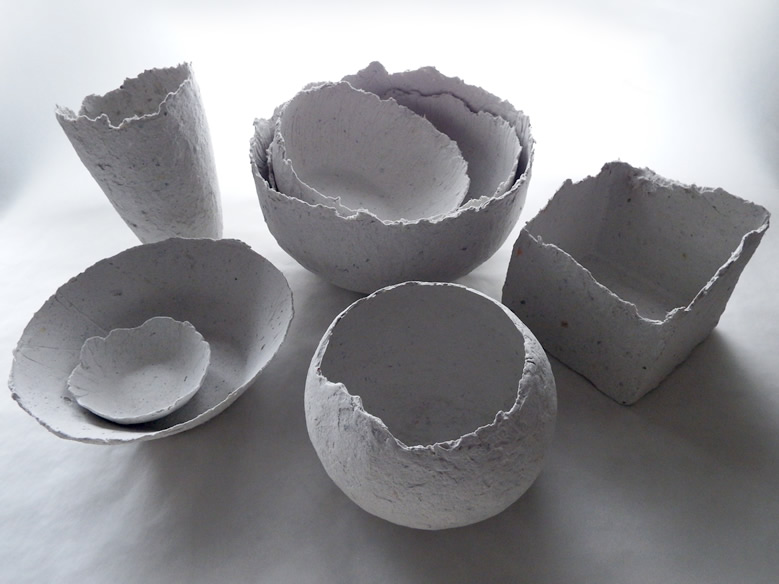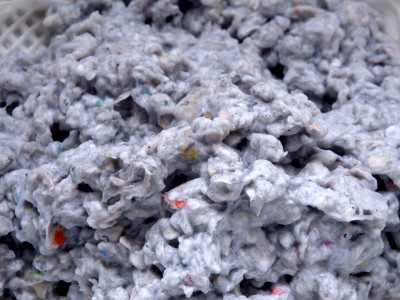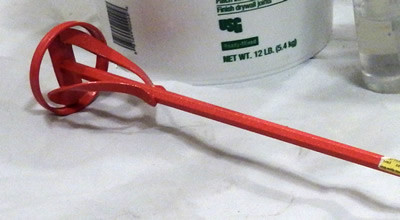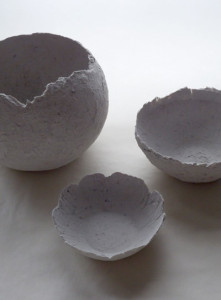
Cast paper bowls are fun to make and I’m a self-confessed container and paper lover. I’ve been making them for a few years, but was sometimes disappointed in the strength of the finished product, especially with larger bowls.
Then one day, I came across ultimatepapermache.com, which has a wealth of wonderful information. Jonni Good offers recipes, clear, helpful videos and the site has an active forum full of even more ideas. It’s obvious that she’s always coming up with ways to improve her techniques.
For my purposes, the recipe needed some tweaking, but it transformed how I make my bowls (and how satisfied I am with them).
Why change a perfectly good recipe?
Recycling

Reusing scrap paper is important to me and is why I started making paper and paper objects in the first place.
So using toilet paper for bowls wouldn’t help me use up all the scrap I have in the basement.
Texture
I like the coarse-ish look and feel of handmade paper and want the option to have this or not in the bowls
Consistency
For my purposes, the clay from the recipe was “wetter” than what would spread and hold well on the molds for my bowls. I needed to thicken it. Jonni Good mentions thickening it with flour, but I only had King Arthur flour and would rather bake with that and use something cheaper for this. That and how the whole “recycling thing” is always on my mind.
Tools

I love the paint mixer that attaches to a drill (Harbor Freight) and didn’t want to use my kitchen hand mixer, so the Red Tornado won out.
I have an old blender for making paper sheets, and it probably gives a finer grain to the paper, but I also wanted to make a large (double) batch.
The recipe below is for a single batch.
Availability
I didn’t have any linseed or mineral oil, but knew from researching other recipes that baby oil was probably close enough.
The new recipe
Tools/Supplies
- Large bucket
- Drill with paint mixer attachment : ) or dedicated hand mixer.
- Tarp or protective covering for the floor (waterproof)
- Measuring cups and spoons
Ingredients
- 2-1/2 cups wet scrap paper, torn into small pieces (1″ square or smaller)
- 1 cup joint compound (not DAP, per ultimatepapermache.com)
- 3/4 cup Elmer’s Glue-All (PVA glue)
- 1/2 cup flour
- 2 tablespoons baby oil
What’s different and how’s that workin’ for ya?

Type of paper – household paper, rather than toilet paper – such as envelopes, copier paper, tissue paper, junkmail newsprint, sandwich or bakery bags (not magazines or anything high gloss). Not as fine a texture, but it has that handmade paper look that I wanted as an option and is easily sanded.
If you want it smoother and still want a recycled paper base, you can moisten the spreader, apply a coat of a papier maché paste or experiment with a similar recipe above, without the paper, as a top coat.
Amount of paper – double the amount to soak up some of the moisture
Baby oil – works well and, as a bonus, it smells fabulous before it dries! You can even smell it when you sand, but you don’t really notice it otherwise.
Making the bowls is almost entirely different for me now.
Before, I’d make a thick sheet of handmade paper in the traditional way, with pulp and a deckle. Then I’d take the sheet and place it over a mold, reshaping as needed. There’s a lot of space, water and mess involved.
Now, the clay can be made up in minutes and excess stored for pathcing or another session, without slopping water everywhere (more comfortable in the winter), no dealing with the deckle pieces and there’s a lot more control over the final result. And did I mention I get to use my paint mixer? I’m a sucker for tools!
The only downside I can see is that it takes a while to get used to how thickly to spread the clay on the mold. The good news is that you can patch or build up any weak spots later and it’s undetectable if you work carefully.
Now that you know how to make the new recipe, how about making some bowls with it?
Learn more from Papier Maché Clay – The Process